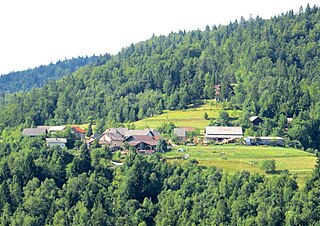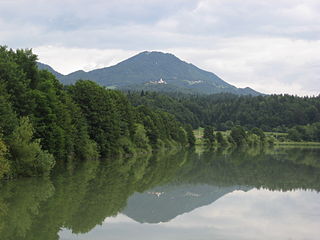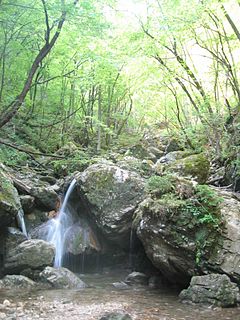
Trbovlje is Slovenia's ninth largest town, and the seat of the Municipality of Trbovlje. It is located in the valley of a minor left bank tributary of the Sava River in the Central Sava Valley in central-eastern Slovenia.

Zagorje ob Savi is a town in the Central Sava Valley in central Slovenia. It is the seat of the Municipality of Zagorje ob Savi. It is located in the valley of Medija Creek, a minor left tributary of the Sava River, 52 km (32 mi) east of Ljubljana 36 km (22 mi) southwest of Celje, and 6 km (4 mi) west of Trbovlje. Traditionally the area was part of the Upper Carniola region. The entire municipality is now included in the Central Sava Statistical Region. The town is home to about 7,000 people. It includes the hamlets of Toplice and Podvine.

Hrastnik is a town in the Central Sava Valley in central Slovenia. It is the seat of the Municipality of Hrastnik. Traditionally the area was part of the Styria region. The entire municipality is now included in the Central Sava Statistical Region. The town has its own library and school.

Styria, also Slovenian Styria or Lower Styria, is a traditional region in northeastern Slovenia, comprising the southern third of the former Duchy of Styria. The population of Styria in its historical boundaries amounts to around 705,000 inhabitants, or 34.5% of the population of Slovenia. The largest city is Maribor.

Slovene dialects are the regional spoken varieties of Slovene, a South Slavic language. Spoken Slovene is often considered to have at least 48 dialects (narečja) and subdialects (govori). The exact number of dialects is open to debate, ranging from as many as 50 to merely 7. The various dialects are so different from each other that a speaker of one dialect may have a very difficult time understanding a speaker of another, particularly if they belong to different regional groups. Speakers of dialects that strongly differ accommodate each other by gravitating toward standard Slovene. Slovene dialects are part of the South Slavic dialect continuum, transitioning into Croatian Kajkavian and Chakavian to the south and bordering Friulian and Italian to the west, German to the north, and Hungarian to the east.

Mački is a small clustered settlement west of Velike Lašče in central Slovenia. The entire Municipality of Velike Lašče is part of the traditional region of Lower Carniola and is now included in the Central Slovenia Statistical Region.

Čeče is a settlement in central Slovenia. It lies in the hills northeast of the town of Trbovlje. Administratively it is divided between the municipalities of Trbovlje and Hrastnik. Traditionally the area was part of the Styria region. It is now included in the Central Sava Statistical Region.

Knezdol is a settlement in the Municipality of Trbovlje in central Slovenia. It is made up of clusters of settlement and isolated farmsteads dispersed though the hills north of the town of Trbovlje. Traditionally the area was part of the Styria region. It is now included with the rest of the municipality in the Central Sava Statistical Region.

Ostenk is a settlement in the Municipality of Trbovlje in central Slovenia. It lies in the hills northeast of the town of Trbovlje. Traditionally the area was part of the Styria region. It is now included with the rest of the municipality in the Central Sava Statistical Region. Ostenk is a scattered settlement on a ridge centered on the Ostenk Crest. It is bordered to the south by Ostenik Hill—which is also known as Žrebelj Hill on the Hrastnik side.

Sveta Planina is a settlement in the Municipality of Trbovlje in central Slovenia. It lies in the hills northwest of the town of Trbovlje. Traditionally the area was part of the Styria region. It is now included with the rest of the municipality in the Central Sava Statistical Region.

Vrhe is a settlement in the Municipality of Trbovlje in central Slovenia. It lies in the hills northwest of the town of Trbovlje and part of the settlement lies in the neighbouring Municipality of Zagorje ob Savi. Traditionally the area was part of the Styria region. It is now included with the rest of the municipality in the Central Sava Statistical Region.

Kal is a settlement in the Municipality of Hrastnik in central Slovenia. It lies in the hills north of Dol pri Hrastniku. Traditionally the area was part of the Styria region. It is now included with the rest of the municipality in the Central Sava Statistical Region. Kal includes the hamlets of Spodnji Kal and Veliki Kal.

The Styrian dialect group is a group of closely related dialects of Slovene. The Lower Carniolan dialects are spoken in central and eastern Slovenian Styria and in the Lower Sava Valley and Central Sava Valley.
The Lower Sava Valley dialect is a Slovene dialect in the Styrian dialect group, bordering on the Lower Carniolan dialect group. It is spoken in the Sava Valley from Litija to Brežice and along the lower course of the Savinja River. It is divided into three subdialects: the Zagorje-Trbovlje subdialect, Laško subdialect, and Sevnica-Krško subdialect.
The Zagorje-Trbovlje subdialect is a Slovene subdialect in the Styrian dialect group. It is a subdialect of the Lower Sava Valley dialect and is spoken in the Central Sava Valley, including the settlements of Zagorje ob Savi, Trbovlje, and Hrastnik.

The Glinščica is a stream in Slovenia.

Lisca is a 948 m hill in the eastern part of the Sava Hills in southeastern Slovenia, northwest of Sevnica, north of the Sava, and south of Gračnica Creek. The hill offers a superb view. It is the most frequently visited hiking destination in the Sava Hills.

The Municipality of Hrastnik is a municipality in central Slovenia. The seat of the municipality is the town of Hrastnik. Traditionally the area was part of the Styria region. The entire municipality is now included in the Central Sava Statistical Region. Located in the valley of a minor left bank tributary of the Sava River, the area is known for its rich deposits of coal. Coal mining began in the area in 1804. Surrounding peaks include Mount Kum (1220 m), Mount Mrzlica (1122 m), and Kopitnik Hill (910 m). The area around Kopitnik is protected as a nature reserve. Species such as the capercaillie and chamois run wild in the surrounding forests.

Borovniščica is a stream that originates in the hills west of Gorenje Otave and flows to the north through Hell Gorge, creating a series of waterfalls, and then through the village of Borovnica. It then flows across the Ljubljana Marsh, where it joins the Ljubljanica River as a right tributary. The upper course of the creek separates the Rakitna Plateau from the Logatec Plateau.
























